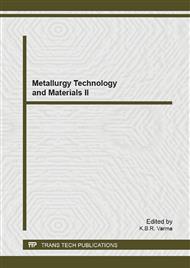p.475
p.479
p.484
p.489
p.492
p.497
p.502
p.506
p.514
Precipitation Phase and Impurities Distribution of Metallurgical Grade Silicon by Vacuum Refining Followed Slag Treatment
Abstract:
Precipitation phase and impurities distribution of MG-silicon were investigated by vacuum refining followed by slag treatment, and the CaO-SiO2-CaF2 system was adopted for slag treatment. Contrasting the microstructure of precipitated phase in slag treatment with and without vacuum refining pretreated, it could be concluded that the composition of precipitated phases, obtained in MG-Si after vacuum refining followed slag treatment, only consisted of Ca-rich intermetallic silicide phases such as Si-Ca-Ni, Si-Ca-Fe and main impurity phase Si-Ca. And the vacuum refining could make an increase in concentration of the impurity Ti due to its low saturated vapor pressure and silicon loss, which was in favor of the interaction with the impurity B, resulting in the formation of TiB2 that could stay at the slag. Consequently, the vacuum refining could be regarded as an effective method for facilitating the removal of B from MG-Si with slag treatment.
Info:
Periodical:
Pages:
492-496
Citation:
Online since:
September 2013
Price:
Сopyright:
© 2013 Trans Tech Publications Ltd. All Rights Reserved
Share:
Citation:


